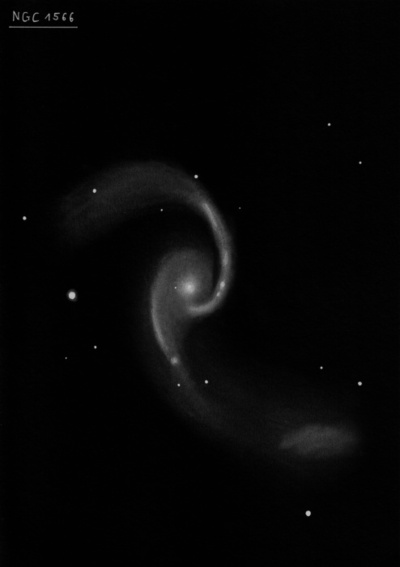
James Dunlop discovered NGC 1566 = D 338 = h2635 on 28 May 1826 with his 9" reflector from Parramatta and described "a pretty large round nebula, about 4' diameter, moderately and gradually condensed to the centre. A very small star near the following edge, not involved." His position is 11' too far south but the identification is certain.
John Herschel observed the galaxy twice from the CGH, recording on 5 Dec 1834, "B, vL, first very gradually then suddenly much brighter to the middle, to a stellar nucleus. Diameter in RA = 15". A star 11th mag involved, N.p. gives it a distorted appearance. A curious object." JH noted this nebula could be Dunlop 338.
Pietro Baracchi observed the galaxy on 7 Dec 1885 with the 48" Melbourne Telescope. His sketch clearly shows both spiral arms and his description reads "the nebulosity is very faint and has a shape almost like the letter S."
300/350mm - 13.1" (2/19/04 - Costa Rica): this Seyfert galaxy is a member of the Dorado Group and appears bright, large, elongated 3:2 ~N-S. With careful viewing the halo extends to ~3'x2'. A spiral arm is attached on the west side and curves towards the north beyond the main body of the galaxy. On the eastern side a low surface brightness arm is attached (on an E-W line with a mag 12 star close following the galaxy) and extends a little to the south on the eastern side of the main body. I was surprised to see the spiral arms so clearly! Mag 8.2 HD 27713 lies 5.4' NW of center and a mag 9.9 star lies in the field 9' W. NGC 1581 lies 40' E.
600/800mm - 24" (11/18/12 - Magellan Observatory, Australia): at 260x, this gorgeous spiral was a showpiece treat even with a 4.5-day moon well up in the west. NGC 1566 appeared strongly concentrated with a very bright, elongated 1' core region that increased to an intense, round, 20" nucleus. The two spiral arms were easily visible with direct vision. The "southern" arm is attached on the north side of the core, wrapping around the core counterclockwise on the east side (passing directly between the core and a mag 12 star 2' E of center) and spiraling around 180? to the south side of the halo. On the south end, the arm passes just north of a mag 15 star and ends at a slightly brighter mag 14.5 star. The "northern" arm is attached on the south side of the core and wraps around the west side, gradually unfurling towards the north side and ending over 2' NNE of center.
With careful viewing, the northern arm "resolved" into 4 distinct extended HII regions, identified as NGC 1566:[HP80] I, II, IV and VI in Hawley and Phillips 1980 paper "Spectrophotometry of H II regions and the nucleus of NGC 1566" in ApJ, 235, 783. NGC 1566:[HP80] VI is a 12" knot in the arm, 45" due west of center and is clearly resolved from [HP80] IV, a slightly larger 15" knot which is 50" WNW of center. [HP80] II is a distinct 10" knot 1' NNW of center and the faintest is [HP80] I, just to its north. The arm passes just south of a mag 14 star 2' N of center. With averted vision, the outer halo extends beyond the main arms, increasing the size to 5'x3' SSW-NNE. Mag 8.7 HD 27713 lies 5.4' NW. NGC 1566 is the largest and most luminous member of the Dorado Group, which contains three subgroups: NGC 1433 group, NGC 1672 group and NGC 1566 group.
Notes by Steve Gottlieb